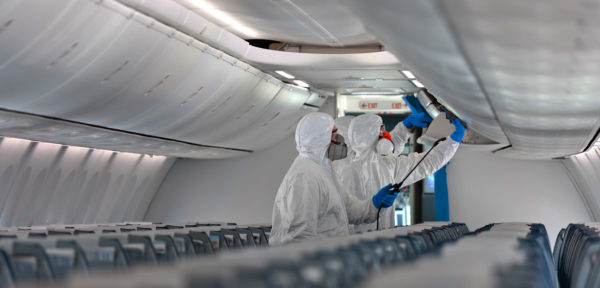Ground handling companies are facing one of the biggest challenges in history. After months of great turbulence, they are finally getting back to service. As the pandemic continues evolving, new regulations emerge to prevent its further spread. To comply with them, two factors are crucial. Current procedures at airports must be reviewed and adjusted. Additionally, managers need to train ground staff to promote skills development and safety awareness.
Ground personnel play a key role in preventing unsafe situations from arising. Investing in their professional growth has been a major concern for the sector. Typically, new qualifications were acquired through in-person training programs. With physical distancing rules now being enforced, there is an increasing demand for alternative methods. Digital learning was already on the rise before the Coronavirus struck. Its growth though will be accelerated as more people work remotely.
Not only have stay-at-home orders posed a challenge for the execution of airport processes. Low passenger traffic levels have obliged companies to cut their capacity. The potential loss of skilled manpower could hinder operations once business picks up again. Decision-makers must then ensure that enough qualified workforce will be available. Keeping personnel who are on temporary leave up to date is a good strategy to achieve this. Customized instruction programs also will be critical to support newcomers onboarding.
Tips to train ground staff amid Coronavirus
1. Identify current skill gaps
Part of the recovery process is to train ground staff on managing COVID-19. As the virus affects people differently, individuals might show a wide range of symptoms. With the development of specific competencies, some of these signs can be recognized. So, personnel in contact with travelers will be able to promptly execute safety procedures. That includes developing meaningful reports on suspected cases.
Ground handling firms have to create awareness of new or amended guidelines to prevent contagion. This information can be delivered in the form of daily briefs or regular workshops such as:
- How to practice proper respiratory etiquette and hand hygiene.
- Adequate use and removal of personal protective equipment.
- Best practices on waste disposal.
The analysis of prior-to-crisis know-how needs serve to layout a Coronavirus training plan. Such an evaluation provides a better understanding of how educational requirements have changed. In the end, adjustments to the learning goals can be done easily. The content of the instruction program must be approved by the competent national authority. This way, employers guarantee compliance with current norms.
2. Establish a learning strategic plan
Building an effective plan requires more than a list of skill sets. Decision makers have to find a training method that aligns with their objectives. Important here is to assess if existing learning resources can be adjusted to the new circumstances. In-house knowledge may not be sufficient to train ground staff for new roles. In such cases, employers could opt to use tailor-made outsourced courses.
The available budget will also define how capacity development will be fostered. The current financial situation prevents ground service providers from significant investments. IATA estimates that revenues for global air transport will fall 50% in 2020 compared to 2019. The crisis is boosting the adoption of more cost-effective training solutions that do not compromise quality. Thanks to e-learning, companies can save expenses such as transportation and printing materials.
One common challenge for ground handling businesses is the complexity and variability of the services they provide. Each airline customer has its specifications and demands. Different levels of expertise would then be expected according to the job function. Online training platforms can promote multi-skilling of staff. Individuals can centrally access a wider range of topics compared to regular seminars. Other advantages from digital courses include:
- Personalized training experience.
- Less-time consuming than traditional face-to-face methods.
- Improves employees‘ performance and engagement.
- Content is accessible anywhere at any time.


3. Assess the results
An old proverb said, “You can´t improve what you can´t measure.” The evaluation of training effectiveness is key to determine if the learning goals were achieved. There is no golden rule for identifying which metrics are more reliable to assess the outcomes. The nature of the tasks and workforce is different from organization to organization. Therefore, it might take some time to get returns (i.e., time, costs, and productivity).
It is highly recommended to determine beforehand the type and amount of data to be collected. This step can facilitate the analysis and reporting of results. Surveys are useful tools to gather feedback and suggestions on the overall instruction experience. Perhaps some employees were not able to retain or understand a lesson’s content. Such input is valuable to better train ground staff in the future.
Training is key to succeed in the post-pandemic world
Personnel are and will always be the most precious asset for companies. The huge level of uncertainty opens questions around how to train ground staff efficiently. According to scientists, Coronavirus is likely to go on for at least two more years. This means that requirements for social distancing, contact tracing, and other measures will continue. Job-specific education on preventing transmission of the virus becomes imperative.
Traditional training facilities will have to adopt COVID-19 protective guidelines to continue offering in-person courses. However, their availability may decrease due to a capacity crunch. E-learning looms as a qualitative and practical option to update ground handling know-how. Digital platforms are so flexible that they can be designed to satisfy industry-specific demands. Such tools are not aimed replacing training on the job, but rather to complement it.
Each company has to prepare a plan to train ground staff, considering current and upcoming manpower needs. As financial resources are limited, the priority should be to qualify workers actively involved in aircraft turnaround. Conscious planning and monitoring determine the success of a capacity-development program. It can be very costly when learning outcomes are not what was expected.
The advantages of training ground personnel during these difficult times are vast. They go beyond the operational level. Travelers may not be familiar with all sanitary protocols implemented at airports. Having staff able to answer any questions in a competent way fosters passenger trust. While airport operations still reflect low air travel numbers, managers must focus on streamlining their learning provision. Then, ground handling companies will be prepared to satisfactorily overcome the crisis.





0 comments on “How To Train Ground Staff During Challenging Times?”